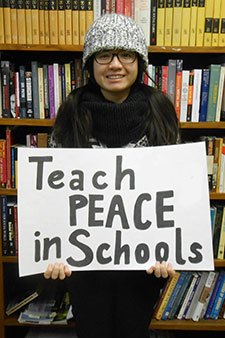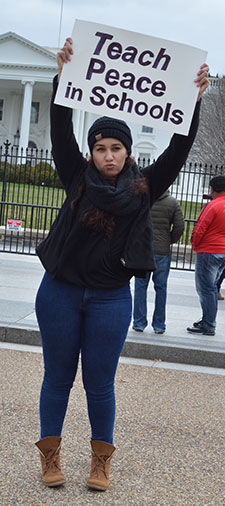Peacebuilding Cornerstone: Teaching Peace in Schools
Bringing into our schools conflict resolution curricula with tools such as social-emotional learning, communication techniques, restorative processes, mindfulness, and other proven peacebuilding skills to increase graduation rates and transform violence, bullying, truancy, and other challenges facing youth.
Statistical Spotlight:
| Up to 42% reduction in physical and verbal youth violence through Life Skills Training in schools.
In West Philadelphia High School, within two years of implementing a Restorative Discipline program, incidents of assault and disorderly conduct dropped more than 65%. |
 Schools are our main social avenue of learning. While the primary focus of teaching in schools is predominantly on academic skills, we feel that life skills are equally important. We face conflict and sometimes violence at almost every stage and in every area of our lives. In fact, conflict that is not dealt with effectively can be one of the biggest detriments to success both in school as well as in life. Youth are the foundation of our future and often can serve as transformed mentors to their friends and family, passing on good practical behaviors and communication technologies.
Schools are our main social avenue of learning. While the primary focus of teaching in schools is predominantly on academic skills, we feel that life skills are equally important. We face conflict and sometimes violence at almost every stage and in every area of our lives. In fact, conflict that is not dealt with effectively can be one of the biggest detriments to success both in school as well as in life. Youth are the foundation of our future and often can serve as transformed mentors to their friends and family, passing on good practical behaviors and communication technologies.
We would like to see basic social and emotional learning, or conflict resolution education, woven into our basic school curriculum. While proven and effective programs and curriculum are happening in pockets all over our nation, we want to see them more systemically embedded. Our policies at the local, state and federal levels have the potential to better reflect and empower these options.
Empowering Strategies and Programs, Proven Efficacy:
Communication Skills: Conflict Resolution Education Curriculum is a key modality. Teachers, staff and administrators are trained to integrate conflict resolution and management as a life skill into existing curricula and to facilitate positive change within the school community by aligning school mission statements, disciplinary procedures, and team-building efforts with conflict resolution concepts and theories.
Social/Emotional Learning: Teaches self awareness, empathy, impulse control, motivation and social skills.
Restorative Circles & Dialogues: This works well right from the start. Children of elementary age start the day in a circle with their teacher. Everyone gets to see each other and do a check-in. In this way, there is space for young ones to share what is happening in their lives. Perhaps a death in the family, a birth, someone in the hospital, divorce… despite the trauma, kids are expected to “behave” and appear normal. Modeling depth is always a good thing and that’s where a teacher willing to be vulnerable is helpful.
 Restorative Justice with trained facilitator: This is when an offense has taken place on school grounds involving one or more persons. All parties impacted by that situation come together and each is pre-interviewed. It is essential that the “offender” is willing to take responsibility and make things better. Victims must agree as well. Both victim and offender are invited to bring support people with them.
Restorative Justice with trained facilitator: This is when an offense has taken place on school grounds involving one or more persons. All parties impacted by that situation come together and each is pre-interviewed. It is essential that the “offender” is willing to take responsibility and make things better. Victims must agree as well. Both victim and offender are invited to bring support people with them.
Mindfulness/Meditation: Mindfulness is a simple but powerful technique to focus attention, manage emotions, handle stress, and resolve conflicts. This allows youth to make wiser decisions in the heat of the moment, rather than only in retrospect.
Peer Mediation: This is Peer-to-Peer mediation and does not involve teachers or adults.
Other examples:
- Nonviolent Communication
- Bullying cessation programs
- Quality after-school and out-of-school programming
- Better school discipline and empowering alternatives to in-school suspension
Policy Proposals:
- Include areas above in Common Core guidelines and funding
- Include areas above in state and local school policies and funding
- Include Restorative Justice and other related programs in U.S. Dept. of Education disciplinary guidelines.
- Implement universal, school-based violence prevention at all schools, particularly in neighborhoods highly impacted by violence
Key Statistics: Challenges and Solutions
Meditation practices in schools have noticeable benefits — studies have shown suspensions decrease by 79 percent, attendance increases by over 98% and academic performance is noticeably increased. [NBC News, Jan. 1, 2015 http://www.nbcnews.com/nightly-news/san-francisco-schools-transformed-power-meditation-n276301]
According to a recent report on the economic benefit of evidence-based prevention programs, the Botvin LifeSkills Training (LST) program produced a $50 benefit for every $1 invested in terms of reduced corrections costs, welfare and social services burden, drug and mental health treatment; and increased employment and tax revenue. [Return on investment: Evidence-based options to improve statewide outcomes. October 2013 (Printed on 3-20-14). Olympia: Washington State Institute for Public Policy.]
Bullied victims are between 2 to 9 times more likely to consider suicide than non-victims, according to studies by Yale University. Suicide is the third leading cause of death among young people, resulting in about 4,400 deaths per year, according to the CDC. For every suicide among young people, there are at least 100 suicide attempts. Over 14 percent of high school students have considered suicide, and almost 7 percent have attempted it. [Int J Adolesc Med Health 20 (2), 2008]
Nearly 1 in 3 students (27.8%) report being bullied during the school year [National Center for Educational Statistics, 2013]. 64 percent of children who were bullied did not report it; only 36 percent reported the bullying. [Petrosina, Guckenburg, DeVoe, and Hanson, 2010]
Restorative Justice programs in a West Oakland Middle School pilot project eliminated violent fights and expulsions, and reduced suspension rates by more than 75%. [Restorative Justice for Oakland Youth http://rjoyoakland.org/programs/]
High schools in Ohio with conflict management programs (Conflict Resolution Education Curriculum) reported that physical violence decreased as much as 43%. The annual cost per student to administer the school conflict management grant training program is approximately $12.00. When compared to the per student cost of suspending a child ($231.00) or expelling a student ($431.00), the program has been cost effective.
Organizations & Links:
The groups are listed here for educational purposes only. Listing them here is not meant to imply that they endorse the above ideas.
Mindful Schools:
They offer online training courses for adults to learn mindfulness and use it with youth. Mindfulness is a simple but powerful technique to focus attention, manage emotions, handle stress, and resolve conflicts. This allows youth to make wiser decisions in the heat of the moment, rather than only in retrospect. Their mindfulness curriculum brings improvements in concentration, attention, and empathy, while building a climate of calm in the classroom.
Film: http://www.mindfulschools.org/resources/healthy-habits-of-mind/
Challenge Day:
Challenge Day’s mission is to provide youth and their communities with experiential workshops and programs that demonstrate the possibility of love and connection through the celebration of diversity, truth and full expression. http://www.challengeday.org
Great Video:
River Phoenix Center for Peacebuilding:
A local organization in Gainesville, Florida, is empowering their community to prevent, reduce, and heal from violence in all forms. They facilitate dialogues, workshops and trainings specifically geared towards fostering better communication and conflict resolution tools for individuals, law enforcement, schools and families.
Great video:
Conflict Resolution Education – Resources for Educators:
People around the globe have started embracing conflict resolution as a key component of a quality education. You can use this site to explore some of the wide array of available materials that support conflict resolution education).
Restorative Justice for Oakland Youth:
Disparately impacting youth of color, punitive school discipline and juvenile justice policies activate tragic cycles of youth violence, incarceration, and wasted lives. Founded in 2005, RJOY works to interrupt these cycles by promoting institutional shifts toward restorative approaches that actively engage families, communities, and systems to repair harm and prevent re-offending.
Botvin Life Skills:
Botvin LifeSkills Training (LST) is a research-validated prevention program proven to reduce the risks of alcohol, tobacco, drug abuse, and violence by targeting the major social and psychological factors that promote the initiation of substance use and other risky behaviors. This comprehensive and exciting program provides adolescents and young teens with the confidence and skills necessary to successfully handle challenging situations.
Peer Mediation Curricula:
An extensive collection of peer mediation training resources for those who seek to help youth more constructively engage peer conflicts. The Peer Mediators curriculum combines common program and training objectives from over a dozen peer mediation curricula and draws upon various standards and best practices guidelines from the realms of youth development, peer mediation, and conflict resolution.
United States Institute of Peace Global Peacebuilding Center’s Peacebuilding Toolkit for Educators:
This Peacebuilding Toolkit for Educators is designed to support the work of educators as peacebuilders. It is a resource developed by and for educators, to enable you to help introduce peacebuilding themes and skills into the classroom.
More to come…
* Peacebuilding is a broad field that covers a wide spectrum of approaches beyond what we spotlight in on in these five cornerstones. Our focus is primarily on those tools that directly improve the basic ways we relate and communicate with one another — enhancing greater cooperation. We advocate for policies, legislation and systems needed to move the work of peacebuilding forward. We welcome the work of all peace advocates and diverse peacebuilding organizations. Our hope is to align our intentions and collective peacebuilding actions for a brighter future.



Leave a Reply
Want to join the discussion?Feel free to contribute!